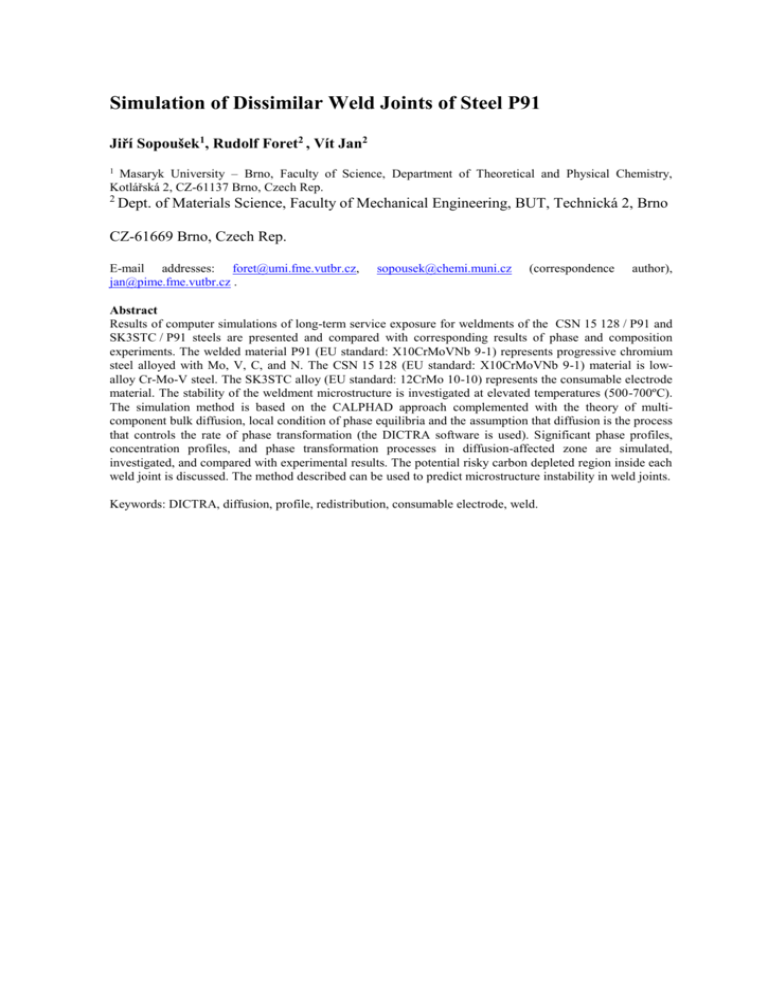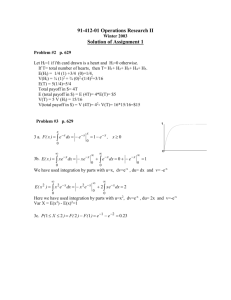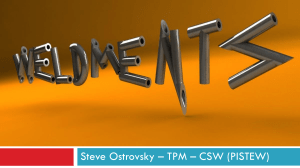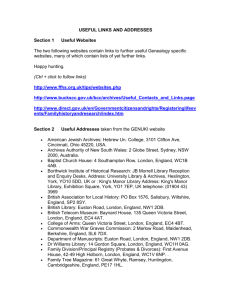Thermodynamic- and Phase Analysis of Multicomponent Creep
advertisement

Simulation of Dissimilar Weld Joints of Steel P91 Jiří Sopoušek1, Rudolf Foret2 , Vít Jan2 Masaryk University – Brno, Faculty of Science, Department of Theoretical and Physical Chemistry, Kotlářská 2, CZ-61137 Brno, Czech Rep. 1 2 Dept. of Materials Science, Faculty of Mechanical Engineering, BUT, Technická 2, Brno CZ-61669 Brno, Czech Rep. E-mail addresses: foret@umi.fme.vutbr.cz, jan@pime.fme.vutbr.cz . sopousek@chemi.muni.cz (correspondence author), Abstract Results of computer simulations of long-term service exposure for weldments of the CSN 15 128 / P91 and SK3STC / P91 steels are presented and compared with corresponding results of phase and composition experiments. The welded material P91 (EU standard: X10CrMoVNb 9-1) represents progressive chromium steel alloyed with Mo, V, C, and N. The CSN 15 128 (EU standard: X10CrMoVNb 9-1) material is lowalloy Cr-Mo-V steel. The SK3STC alloy (EU standard: 12CrMo 10-10) represents the consumable electrode material. The stability of the weldment microstructure is investigated at elevated temperatures (500-700ºC). The simulation method is based on the CALPHAD approach complemented with the theory of multicomponent bulk diffusion, local condition of phase equilibria and the assumption that diffusion is the process that controls the rate of phase transformation (the DICTRA software is used). Significant phase profiles, concentration profiles, and phase transformation processes in diffusion-affected zone are simulated, investigated, and compared with experimental results. The potential risky carbon depleted region inside each weld joint is discussed. The method described can be used to predict microstructure instability in weld joints. Keywords: DICTRA, diffusion, profile, redistribution, consumable electrode, weld. 2 Introduction A weld joint of dissimilar materials under external stress usually represents a critical point in many technical solutions involving elevated temperatures. The investigation of the relationships among the element/phase redistributions, the microstructure at various points across the weldments, and local mechanical properties represents a method that is suitable for the evaluation of long-term mechanical/microstructure stability of weld joints [98Pil]. In the case of weld joint applications at elevated temperatures, the mechanical properties can be related to chemical concentration and phase transformation processes in the diffusion-affected zone [89Buch], [90Wit] [95Mil]. Information on the time evolution of both the phase and the element redistributions at a given temperature treatment is therefore very important. The main factors that influence the stability or instability of the weld joint of steels are, above all, carbide nucleation, phase transformation, rate of diffusion [00Rin], and carbon depletion [98For]. These factors are significantly dependent on temperature. Phase transformations in weld joints of multi-component alloys have become very complex due to the high degree of freedom of the multi-component system [90And], [86Por]. The diffusion fundamentally affects the rate of phase transformations at elevated temperatures [85Kir] and the changes in chemical potentials of the elements are consequently the cause of phase precipitations, growth, phase dissolutions, and/or phase boundary replacement in the weld diffusion zone. In many cases, regions parallel to the initial weld interface are formed in the diffusion-affected zone, with different microstructures having different mechanical and corrosion-resistant properties. The theoretical and experimental methods for multi-component alloy weldment investigations were limited in the past. The main theoretical problem was the absence of a more complex model for multi-component welded alloy system with dispersed phases that can describe the processes occurring in the weld joint with satisfactory accuracy. If we accept that a diffusion couple [98Sau] may approximate a weld joint, it is then possible to perform a simulation of weldment temperature exposure using a model based on the CALPHAD approach [98Sau] and complemented with the assumption that diffusion is the controlling process of the phase transformation rate [85Kir], [94Eng], [00Bor], theory of multi-component bulk diffusion [90And], thermodynamic evaluation of the driving force for phase transformations, and the assumption of local condition of phase equilibria. This complex model is also implemented in the DICTRA software package [98DIC] and it enables a prediction of the sequence of phase regions across the investigated weldment, which are formed during the temperature exposure. The different creep strain rates are generally in different regions of the weldment under external stress and this leads to the generation of increased mismatch stresses and earlier failure. The aims of this study are: to present the results of weldment simulations for two weldments (CSN 15 128/P91 and SK3STC/P91), to compare the theoretical results with the foregoing experiments [01For] [99Mil] [01Svob], and to suggest the relation between the simulated phase region sequence, weldment microstructure and mechanical properties of the weld joint. It is hoped that this approach will be accepted as a progressive tool for weld design. Subject of investigation The following materials and their weld joints will be in the focus of our study (see Table 1 for detailed compositions): P91 steel alloyed with chromium and small amounts of Mo, V, and N, 15 128 low-alloy CrMo-V steel (according to Czech standard CSN 41 5128), and the consumable electrode material (Chromocord SK3STC). The progressive P91 steel represents creep-resistant chromium steel for industrial application [01Wil], [99Orl], [98Cad]. The 15 128 low-alloy steel mentioned above is a frequently used steel because it gives a good combination of mechanical properties, resistance to corrosion, and cost. The foregoing long-term (up to 10 000 hrs) experiments [01For], [01Svo], [99Mil] in the temperature range from 500 to 700ºC confirmed that the matrix of each investigated diffusion couple preserved the BCC_A2 (referred to as α in the following) structure with time- and distance-dependent arrangement of carbides and/or carbonitrides. The development of the following dispersed phases was observed in the weldments: chromium- rich carbides M7C3 and M23C6, special chromium-poor carbide (M23C6), molybdenum- rich carbide M6C, molybdenum- and vanadium-rich carbide (M2C), vanadium-rich carbonitride (MX, where X stands for C or N). Simulation model The following simplifying fundamental assumptions were used in our model. The metastable phases or the stable phases with non-equilibrium compositions formed before post-weld heat exposure were excluded from 3 the simulation. The width of the fusion zone was put equal to zero because the experimental fusion zone was also small (about 3·10-6 m). No heat-affected zone generated during the weldment preparation was supposed. The initial state of the weldment was approximated by two systems, each in equilibrium. In our simulations, the CALPHAD approach [98Sau] was used for the solution of both local and global phase equilibrium problems in the steels investigated. Every investigated steel represents a multi-element system with several phases: the matrix phase including dispersed phases (carbides and/or carbonitrides). The CALPHAD approach enabled a solution based on constrained minimization of the total Gibbs energy in a closed system at a given composition, temperature and pressure. In short, the total Gibbs energy is calculated as a sum of molar phase Gibbs energies weighted by phase ratios. Using an appropriate thermodynamic model [81Sun], [48Red], [70Hil], [78Hil], [75Ind], [81Ind] the molar phase Gibbs energy can be evaluated as a function of temperature, pressure, phase composition and so-called thermodynamic parameters (TP). The parameters for selected phases and selected systems that represent the subsystems of the steels under examination can be found in the relevant literature. Numerically, this problem can be solved using available software packages ([97TC], [89Pan], [93Sop], [E-FACT], [E-malt], etc.). The following elements were considered for thermodynamic description of the materials examined: Fe, Cr, Mo, V, C, N (cf. steel composition in Table 1). The Gibbs energy of the phases existing in this 6-element system was described using thermodynamic parameters from the STEEL12.TDB database [01Kro]. This database contains data for the following subsystems: Fe-Cr-C, Fe-Mo-C, Fe-V-C, Fe-N-C, Fe-Cr-N, Fe-C-N, Cr-V-C, Cr-Mo-N, Mo-V-C, Cr-Fe-V and some data for higher subsystems: Fe-Cr-Mo-C, Fe-Cr-V-C, Cr-VMo-C, Cr-Fe-Mo-V-C. The phases were described using a regular solution model for phases with several components and sublattices [81Sun]: b.c.c phase as the magnetic ALFA??? BCC_A2 phase with two sublattices: (Fe,Cr,Mo,V)1(C,N,Va)3, where Va stands for vacancies, M23C6 as the stoichiometric phase with 3 sublattices (Cr,Fe,V)20(Cr,Fe,Mo,V)3C6 , M7C3 carbide as the stoichiometric phase with two sublattices (Cr,Fe,Mo,V)7C3, M6C using 4 sublattice description Fe2Mo2(Cr,Fe,Mo,V)2C, vanadium reach carbide M2C and vanadium-rich carbonitride MX were modelled as a non- stoichiometric phase (Fe,Cr,Mo,V)1(C,N,Va)1 using the parameters for the FCC_A1 phase [92Lee]. This description was used to evaluate all the equilibrium quantities or functions presented (equilibrium composition, chemical potential, activity, etc). In the case of heterogeneous weldment, a gradient of the chemical potential can be observed and the diffusion [85Kir] of the species is going on at elevated temperatures. The changes in the chemical potentials of the species form the thermodynamic ground for phase transformations, phase precipitation, growth and/or phase dissolution. In our paper the DICTRA [98DIC] program (including the ThermoCalc routines [97TC]) was used for the simulation of the post-weld heat exposure. This model deals with element mobilities [92And] for diffusion matrix evaluation. The same selection of the species as for the thermodynamic description was considered for the kinetic description. The major interstitially diffusing species are carbon and nitrogen but the diffusion of the other substitutional species (Fe, Cr, Mo, and V) was also taken into account. The weldments were simulated as one-dimensional diffusion couples. Steel kinetics was approximated using the kinetic parameters for carbon and nitrogen mobility evaluations in the ALFA???? BCC_A2 phase based on Fe-Cr-C and Fe-Cr-N [94Jo1], [02Jan] subsystems. The trace [82Kuč] [82Oik] diffusions of substitutional elements in iron were included too. The carbide and carbonitride phases were treated as non-diffusion spheroid phases suspended in the matrix. A local equilibrium between the matrix and the carbide/carbonitride phases was assumed in each part of the diffusion couple. Simulation results The simulation method used enabled us to predict any of kind of phase diagram cross-section of all the investigated alloys. The presented phase diagram cross-sections (P91: Fig. 1, 15 128: Fig. 2) show equilibrated phases. The activities of the elements were calculated for the investigated alloys too. The carbon activity in the investigated steels is given in Fig. 3. The simulation using the DICTRA program offers the time- and distance-dependence (profiles) for many values (molar phase ratio, overall concentration, both matrix and carbide element concentrations, activity, chemical potential, etc.). With respect to the experiment, the phase profiles and overall element concentration profiles are the most interesting. Sometimes, the element composition profile of the individual phase can be in the focus of attention too. A simultaneous plot of the phase profiles is best-suited to distinguish the phase regions across the weldment, the loading of the phases in the regions, as well as the width of the regions. The simulation results for two selected weldments are given in Fig. 4 and Fig. 5. Generally, the sequence of the phase regions observed in the couple is time independent, the rate of the region interface motion increases non-linearly with the 4 distance from initial weld interface, and the region width increases approximately with the square root of the time. The phase region sequences for simulated weldment combinations are summarized in Table 2. These sequences enabled us to illustrate carbide reactions running in the weldments at given temperatures. The simulation enabled the calculation of the time- and distance-dependence for the composition of the dispersed phases too. The carbonitride composition profile for the 15128 / P91 weldment after post-weld heat treatment is given in Fig. 6 and the composition profile for the M23C6 carbide is in Fig. 7. The overall concentration profiles can also be obtained from the simulation and they can be easily compared with experimental measurement [01For], [01Svo], [99Mil]. Two experimental and simulated overall carbon concentration profiles are given in Fig. 8, where numerous experimental observations [01For] are supplied by fitted experimental curves. Discussion The CALPHAD method enables us to calculate the phase diagram of steels with high reliability and without much experimental work. The phase diagram predictions in Figs 1 and 2 obtained using the STEEL12 thermodynamic database [01Kou] can be performed for technical steels too. The phase diagram predictions may differ if we use a different thermodynamic database (for example SSOL [97TC]) especially in low temperature ranges. However, we believe that our thermodynamic database yields more accurate results because the STEEL12 database is optimized for lower temperatures. The same emphasis is placed on the consistency of the DIF12 kinetic database [02Sop] at low temperatures. The high-temperature microstructure stability or instability of dissimilar weldments may be considered in different ways. In the first approximation, the element activity in steels can be used as a determinative value for weld joint stability. The carbon and/or nitrogen is of utmost importance (see Fig. 3). From this simple view, the SK3STC steel represents a convenient electrode material for the fabrication of the 15 128 / SK3STC / P91 complex weld joint because the curve of carbon activity of the consumable lies between the curves for joined materials. However, this approach is not sufficient for a long-term stability/instability judgement. In the second approximation, the simulated phase and element profiles can be used for an estimation of the life time of weld joints and consequently of the time remaining for all technological facilities. The phase region sequence (see Table 2) and phase profile (see Figs 4 and 5) can help us to find the weakest point inside the weldment because the mechanical properties of the region can be estimated from the phase microstructure [01Raj]. This approach assumes that the weldment simulation results are correct. The simulation result corresponds with experimental observations [01For], [01Svo], [99Mil] and any possible discrepancies observed can be easily explained by the limitations of experimental technique, preweld heat treatment, or simulation model limitations. The carbide types found experimentally in steels weldments correspond well with the diffusion couple simulation (see Figs. 4 and 5). All this confirms the stability of MX carbides during post-weld temperature exposure across the whole 15 128 / P91 weldment (Fig. 4), M23C6 carbide nucleation and coarsening in the P91steel, carbon-depleted zone close to the initial weld interface (see Fig. 8 ), etc. The simulation also shows the same predominant M6C carbide that formed a narrow band of coarse carbides on the experimental 15 128 / P91 weld interface [01For] (Fig. 4, Table 2). Further, the simulations confirmed the existence of the phase regions: α+MX (15 128 / P91) and α+M6C (SK3STC / P91), which were found experimentally inside the carbon-depleted zone (see the temperature range including 625˚C in Table 2). The experimental and simulated carbide/carbonitride compositions are in a good agreement too. For example, the simulation confirmed the variation in the M23C6 carbide composition in the experimental 15 128/P91 weldment [01For] (see Fig. 6), the simulated chemical composition of MX carbonitride (Fig. 7) reflects the experimental metal content, the simulations predict carbon-rich and nitrogen-rich carbonitrides, etc. Examples of the experimental and the simulated bulk carbon profiles are in Fig. 8. The extreme experimental values (peak maximum/minimum) agree in the limit of accuracy of the experimental measurement with the simulated values. In Fig. 8, we can see the lower simulated maximum of carbon concentration in the 15 128 / P91 weldment carburised zone. It can be easily explained by grain boundary diffusion, which is not included in the simulation model. It can be said that both weldment combinations (15 128/P91, SK3STC/P91) represent quite solid joints under the monitored conditions. However, there is a risk of decarburising the BCC_A2 zone formed during long-term exposure. This risk is reduced by carbide and/or carbonitride particles. It was found by simulation and also by experiment that the decarburised 15 128/P91 zone contains the MX carbonitride and the decarburised SK3STC/P91 zone contains the M6C carbide. The M 23C6 carbide predominates in the carburised zones of both weldments. The 15 128/P91 (see Table 2) simulated phase region sequence 5 includes a central (+MX) | (+M6+MX) subsequence with a high amount of M6C carbide. It reflects the experiment [01For]. These M6C carbides formed a narrow band of huge particles. Other phases (LAVES, M2C, V4C3 , PI ) were also considered in weldment simulation. One of them, the LAVES phase, represents a great risk. This phase has not been mentioned because it is not stable under the simulated conditions but a small concentration shift or addition of another LAVES phase stabilising element (namely Mn) may be the cause for the LAVES phase precipitating in the P91 steel or in the decarburised zone. The simulation confirms that the LAVES phase occurs at temperatures below 600˚C and at lower carbon concentrations (approx. <0.01wt %). Conclusion The above approach and the simulation results enabled us to better understand the microstructure processes and carbide and/or carbonitride phase transformations occurring in the diffusion zone of the investigated weldments. It can be generally said that the method applied yields results that reflect the weldment phase structure quite correctly. A good agreement was found in the sequence of the carbide and/or carbonitride phase regions. The performed kinetic simulations provided information that can be used for failure-risk prediction for weld joints. The simulated phase profiles for the vanadium-rich MX carbonitride and the fine-size M6C carbide showed their high microstructure-stabilising effect IN nebo ON ??? the carbon-depleted zone. Special attention must be paid to the concentration balance, which may be responsible for the LAVES phase precipitation in weldments that include the P91 steel. The simulation results save time and expenses in the evaluation of long-term microstructure stability of the weldments examined. The profiles presented can serve for the prediction of microstructure development and estimation of the mechanical stability of the weldments under external stress during long-term service. Acknowledgements The support of the Grant Agency of the Czech Republic (No: 106/00/0855) is gratefully acknowledged for funding. The calculations were performed with the aid of the ThermoCalc and DICTRA programs. Sincere thanks are extended to Prof. Vřešťál for thermodynamics and kinetics calculations. References [02Jan] [02Sop] [01Kro] [01For] [01Raj] [01Svo] [01Wil] [00R97] [00Bor] [48Red] [75Ind] [70Hil] [78Hil] [81Ind] [81Sun] [82Kuč] V. Jan, J. Sopoušek, R. Foret: Proc. of Conf.: ‘Metal 2002’, Hradec nad Morvicí, Czech Rep., May 2002, 1-7. V. Jan, J Sopoušek: Proc. Int. Conf. on: ‘Thermodynamics of Alloys TOFA 2002‘, Roma, September 2002, Univ. di Roma „La Sapienza“, PO 55. A. Kroupa, J. Havránková, M. Coufalová, M. Svoboda, and J. Vřešťál: Journal of Phase Equilibria 22/3 (2001) 312-323. R. Foret, B. Million, M. Svoboda, and K. Stránský: Sci. and Technol. Weld. Joining, 2001, 6, 405-411. R. Rajeev, I. Samajdar, R. Raman, C. S. Harendranath, and G. B. Kale: Mat. Sci. Technol., 2001, 17, 1005-1011. M. Svoboda, I. Podstranská: Microstructural Changes in CSN 15128/P91 Steels Weldments, In Corrosion-resistant Steels and Alloys at the Turn of Century, Řeka 5.-7. 10. 1999, Czech Rep. Welding offers utilities answers about new chrome-moly steel ; Irving, Bob; Welding Journal [H.W. Wilson - AST]; Sep 2001; Vol. 80, Iss. 9; pg. 40 Praktické použtí The Ringberg Workshop 1997 on the Application of Computational Thermodynamics, Calphad 24/1 (2000) 15-94. A. Borgenstam, A. Engstrőm, L. Hőglund, J. Ägren: J. of Phase Equilibria, 2000, 21, 269280. O. Redlich and A. T. Kister: Ind. Eng. Chem., 1948, 40, 345-?. G. Inden: Z. Metallkd., 1975, 66, 577-?. M. Hillert and L. I. Staffanson: Acta Chem. Scand., 1970, 24, 3618-3656. M. Hillert, M. Jarl: CALPHAD, 1978, 2, 227- ?. G. Inden: Physica, 1981, 103B, 82-?. B. Sundman and J. Ågren: J. Phys. Chem. Solids, 1981, 42, 297-301. J. Kučera and K. Stránský: Mat. Sci. and Eng., 1982, 52, 1-38. 6 [82Oik] [85Kir] [86Por] [89Pan] [90Wit] [90And] [92And] [92Lee] [93Sop] [94Eng] [95Mil] [97Eng] [97TC] [98Cad] [98For] [98DIC] [98Pil] [98Sau] [99Mil] [99Orl] H. Oikawa: ‘Lattice Diffusion of Substitutional Elements in Iron and Iron-Base Solid Solutions’, Technology Reports, Tohoku Univ., 1983, 7-77. Kirkaldy, J. S.; Young, D. J. : Diffusion in the Condensed State, The Institute of Metals, London (1985). D. A. Porter, K. E. Easterling: Phase Transformations in Metals and Alloys, The Thetford Press Ltd. England (1986). PANDAT Software for Multicomponent Phase Diagram Calculation, CompuTherm LLC, Madison, Wiscosin USA (2000) M. Witwer, H. Cerjak, and B. Buchmayr: Proc. Int. Conf. on ‘High temperature materials for power engineering’, Liege, Belgium, September 1990, Université de Liège, 751-760. Andersson, J.-O.; Hőglund, L.; Jőnsson, B.; J. Ägren: in: G. R. Purdy (ed.), Fundamentals and Applications of Ternary Diffusion, Pergamon Press, New York (1990) 153-163. J. O. Anderson and J. Ägren: J. Appl. Phys.,1992, 72, 1350-1355. B. J. Lee and D. N. Lee: J. of Phase Equilibria, 1992, 13, 349-363. J. Sopoušek, A. kroupa, R. Dojiva, J. Vřešťál: The PD-Package for Multicomponent Isobaric Phase Equilibrium Calculations, CALPHAD 17 919930, 229-236. Engstrőm, A.; Hőglund, L.; Ägren, J.: Metall. Mater. Trans. A 25 (1994) 1127-1134. B. Million et al.: Z. Metallkd., October 1995, 86, 706-712. A.Engstrőm, J. E. Morral, .; Ägren, J.: Computer simulations of Ni/Cr/Al Multiphase diffusion Couples, Acta mater. 45 (1997) 1189-1199. ThermoCalc (v. M) User`s Guide, Div. of Comput. Thermodynamics., Dept. of Mater. Science and Engineering, Royal Inst. of Technology, Stockholm (1997) Cadek J, Sustek V, Pahutova M An analysis of a set of creep data for a 9Cr-1Mo-0.2V (P91 type) steel MAT SCI ENG A-STRUCT 225: (1-2) 22-28 APR 30 1997 R. Foret, K. Stránský, J. Krumpos, B. Million, V. Pilous: Proc.Int. Conf. on ‘Integrity of HighTemperature Welds’, kde?, zeme?, Kdy< 1998, The Institution of Mechanical Engineers, The Ipswich Book Company,, Suffolk, UK, 135-142. DICTRA (v. 20) User`s Guide, Div. of Physical Metallurgy Dept. of Materials Science and Engineering, Royal Inst. of Technology, Stockholm (1998) Pilous, V.; Stránský, K: Structural Stability of Deposits and Welded Joints in Power Engineering, Cambridge Int. Science Publ., Cambridge (1998) Saunders, N.; Miodovnik, A. P.: CALPHAD (Calculation of Phase Diagram) - A Comprehensive Guide (Pergamon Materials Series, Vol. 1), Elsevier Science, Amsterodam (1998). B. Million, R. Foret, A. Rek, et al.: Carbon redistribution during long-term operation of weld joints of creep-resisting chrome steels,KOVOVE MATER 37: (5) 314-323 1999. P91/15128 P91/Cr3Mo1C Orlova A, Bursik J, Kucharova K, et al. Microstructural development during high temperature creep of 9% Cr steel MAT SCI ENG A-STRUCT 245: (1) 39-48 APR 30 1998 [E-FACT] Web Sites in Inorganic Chemical Thermodynamics, FACT: http://www.crct.polymtl.ca/fact/websites.htm [E-Malt] Thermodynamic database : MALT2: http://www.kagaku.com/malt/emalt2.html 7 Table 1: Chemical composition (in wt%) of the steels. Steel C Mn Si P S Cr Ni Mo V N Nb P91 0.10 0.40 0.43 0.015 0.006 8.50 0.10 0.88 0.23 0.045 0.018 CSN 15 128 0.13 SK3STC 0.12 0.60 0.31 0.012 0.022 0.58 0.07 0.47 0.25 - - 0.80 0.07 0.008 0.011 2.73 0.02 0.96 0.01 - 0.013 Table 2: Weldment combinations, annealing conditions and simulated phase region sequences. Phase (used abr.): BCC_A2 (α), M7C3 (M7), M23C6 (M23), M6C (M6), carbonitride (MX). Symbol “<” means: interface is moving to the left with time; “>” means: moving to the right; “|” means: movement not observed. Weldment combinations Temp. [ºC] phase region sequence (predominant carbide/carbonitride bold) CSN 15 128 /P91 500-561 (+M7+MX) < (+M23+M7+MX) < (+M7+MX) < (+MX) | (+M6+MX) > (+M6+M7+MX) > (+M23+M6+M7+MX) > (+M23+M6+MX) CSN 15 128 /P91 561-577 (+M7+MX) < (+M23+M7+MX) < (+M7+MX) < (+MX) | (+M6+MX) > (+M6+M7+MX) > (+M23+ M6+ M7+MX) > (+M23+M7+MX) > (+M23+MX) CSN 15 128 /P91 577-655 (+M23+M7+MX) < (+M7+MX) < (+MX) | (+M6+MX) > (+M6+M7+MX) > (+M23+ M6+ M7+MX) > (+M23+M7+MX) > (+M23+MX) CSN 15 128 /P91 655-700 (+M23+MX) < (+MX) | (+M6+MX) > (+M6+M7+MX) > (+M23+ M6+ M7+MX) > (+M23+M7+MX) > (+M23+MX) SK3STCC /P91 500-554 (+M23+M6) < (+M6) < (+M23+M6) | (+M6+M23+MX) > (+M23+MX+M6) > (+M7+MX+M23+M6) > (+MX+M23+M6) SK3STCC /P91 554-556 (+M7+M6+M23) < (+M23+M6) < (+M6) < (+M23+M6) | (+M6+M23+MX) > (+M23+MX+M6) > (+M7+MX+M23+M6) > (+MX+M23+M6) SK3STCC /P91 556-561 (+M7+M6) < (+M7+M6+M23) < (+M23+M6) < (+M6) < (+M23+M6) | (+M6+M23+MX) > (+M23+MX+M6) > (+M7+MX+M23+M6) > (+MX+M23+M6) SK3STCC /P91 561-700 (+M7+M6) < (+M7+M6+M23) < (+M23+M6) < (+M6) < (+M23+M6) | (+M6+M23+MX) > (+M23+MX) > (+M7+MX+M23) > (+MX+M23) 8 Figure captions and figures Figure 1: Phase diagram cross-section for steel P91. Figure 2: Phase diagram cross-section for steel SK3STC. 9 Figure 3: Carbon activity of the steels at different temperatures. 1 carbon activity 0.1 0.01 CSN 15128 (0,13wt%C) SK3STC (0,12wt%C) P91 (0,10wt%C, 0,045%N) 0.001 0.0001 600 800 1000 temperature / t, o C Figure 4: Simulated phase profiles for CSN 15 128/P91 weldment at 625ºC after 5000hrs . M6C ¯ molar phase ratio 0.12 ¯ M7C3 M23C6 M6C M7C3 0.08 MX carbonitride 0.04 M23C6 MX MX 0 -0.008 -0.004 0 0.004 distance / m 10 Figure 5: Simulated phase profiles for SK3STC/P91 weldment at 625ºC after 5000hrs . 0.1 molar phase ratio 0.08 MX carbonitride M23C6 M6C 0.06 M7C3 M23C6 0.04 0.02 M7C3 M6C 0 -0.004 MX -0.002 0 0.002 distance / m Figure 6: The simulated chemical composition of the MX carbonitride in dependence on distance from interface (CSN 15 128/P91 weldments, 625ºC/5000hrs) . MX phase composition / wt fraction 0.8 0.6 V 0.4 0.2 Mo N C Cr Cr 0 -0.008 -0.004 0 0.004 0.008 distance / m 11 Figure 7: The simulated chemical composition of the M23C6 carbide in dependence on distance from interface (15128/P91 weldments, 625ºC/5000hrs) . M23C6 composition / wt. fraction 0.8 Cr Fe 0.6 region without M23C6 carbide 0.4 chromium rich M23C6 carbide chromium poor M23C6 carbide 0.2 Fe Cr Mo Mo C 0 V V -0.008 -0.004 0 0.004 distance / m Figure 8: The simulated and experimental overall concentration profiles at 625ºC/5000hrs. overall carbon concentration / wt % 1.6 exp. CSN 15128/P91 simul. CSN 15128/P91 exp. SK3STC/P91 simul. SK 3STC/P91 1.2 0.8 0.4 0 -0.002 -0.001 0 0.001 0.002 distance / m Correspondence addresses Jiří Sopoušek (corresponding author): Masaryk University, Faculty of Science, Department of Theoretical and Physical Chemistry, Kotlářská 2, CZ-611 37 Brno, Czech Republic sopousek@chemi.muni.cz, fax: 00420 541211214 12





